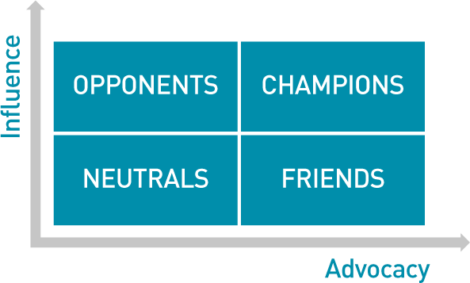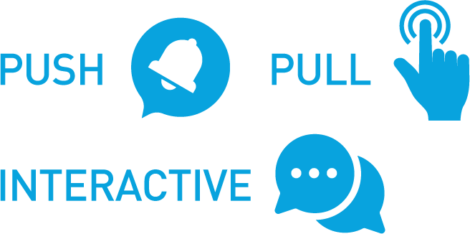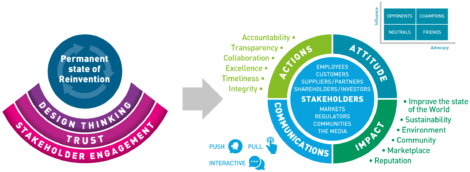Why Stakeholders? Why think differently? If you’ve worked for a “business as usual” organisation, you may well have heard these statements:
- The customer is king
- It’s all about shareholder value
- Our people are our greatest asset
For a Mutable Business™ none of those statements are fit for purpose, although they each contain an important degree of truth. How do you reconcile them, and what else should you be considering? Mutable Business™ thinkers agree with Jack Welch, the CEO of GE when, in 2009, he famously declared that concentrating on shareholder value is “the dumbest idea in the world.” We also agree with Marc Benioff, Chairman and CEO of Salesforce when he suggested in a Huffington Post article that this still-pervasive business theory is “wrong. The business of business isn’t just about creating profits for shareholders – it’s also about improving the state of the world and driving stakeholder value.”
A business strategy with too much emphasis on quarterly financial performance and earnings per share will fail in today’s business landscape with today’s workforce. We can pull out other quotes from Jack Ma of Alibaba, Xavier Huillard Vinci Group, Paul Polman of Unilever, John Mackey of Whole Foods. We should have been thinking this way for a long time. 40 years ago, Alvin Toffler, in his book The Third Wave, told us that the corporation “requires attention to multiple bottom lines – social, environmental, informational, political and ethical – all of them interconnected.” John Elkington coined the term Triple Bottom Line (TBL) back in the 90s. By that he was explaining investment and business decisions in terms of People, Planet and Profit.
Stakeholders
We need to think beyond shareholders to include all of our Stakeholders. Who are they? Our definition of a Stakeholder includes any entity, role or person who can have an impact on your organisation’s performance. So as well as shareholders and investors, that obviously includes customers, suppliers, business partners as well as the advisors they work with, but also the markets you operate in, the regulators of those markets, the media organisations and influencers that you interact with, and all of the associated communities that your organisation and its people touch. Add in the governments of the countries and territories that your organisation operates in, and that is a big and diverse set of audiences and individuals to engage with. Each can have an impact on your business. Your actions and your attitude towards each of them will make them react positively or negatively. How you communicate with them will make the difference.
A new kind of Engagement
We need a new kind of engagement that isn’t based on press releases, investor briefings, annual meetings and good words in the annual report. We need a new kind of approach to engagement and communications – a Mutable approach that embraces continuous reinvention, allowing you to communicate clearly and activate the right people at the right time.
What is the Stakeholder’s Attitude?
Every different Stakeholder needs to be assessed and included in your engagement strategies, tactics and policies. Think of each one in terms of a 2×2 matrix with the axes of Influence and Advocacy (see diagram). Those with high influence and low advocacy of your organisation are your Opponents. Those with low Influence and high Advocacy are your Friends. Of course, there are the Neutrals too with low Influence and Advocacy. Those with high Influence and high Advocacy in the top right box are your Champions, and you need to encourage and support them. Opponents, Neutrals, and Friends – actually you need a continuous approach to address all of them as groups and individually with the objective of turning them all into your Champions.
Your Actions
Everything is connected, but engagement starts with how you go about your business. From how you design your products and services to how you handle customer complaints – all of your processes and actions can be swiftly under the microscope in today’s world of instant communications and social media. From how you hire your staff, to how you develop them, treat them and trust them. Your shared values as an organisation are crucial. Your approach should be more diverse, inclusive, equal, sustainable, and meaningful. Your own “business as usual” should be based on the characteristics of:
- Accountability
- Excellence
- Integrity
- Transparency
- Collaboration
- Timeliness
Your Impact
Your actions always have an impact. Will it be positive or negative? What you do as a business touches nature, people and society. In today’s hyper-connected world, you need to behave as if everything you say and do internally might become public. Think about how the “what” and “how” of what you do impacts:
- Improving the state of the World
- Sustainability
- The environment
- Your community
- Your marketplace
- Your reputation
A Mutable Business™ needs to consider all of these impacts and possibilities in the continual process of planning, design, and execution of its purpose, mission and goals, as well as crisis management or what happens when things go wrong. The global changes we have lived through since 2020 highlights the importance of sustainability in particular. It’s good for the planet, it’s good for business, and it needs to be integrated in to your thinking every step of the way. In today’s complex world small things can cause massive outcomes. There are so many variables. You can’t plan, but you can be prepared. The Mutable Business™ can’t expect the unexpected, but it must have robust processes in place to react when needed.
Communications
For this new kind of engagement, your business needs to communicate with each and all of their Stakeholders in different ways at different times, embracing the new communication and collaboration paradigms of today. A combination of Push, Pull, and Interactive communications are an integral part of any modern, digital communication strategy.
Push is a broadcast. It refers to any message sent from a sender to a receiver, either individually or as a mass mailer, a message on a bulletin board, a notice on a website, even an SMS message to alert the stakeholder of an issue. It could be messages published on old media too. The sender is in control, determining who receives the communication, how they receive it, and when.
Pull is self-service communication. A stakeholder, employee, customer, partner, analyst, or community member accesses information on their own terms. It could be online documentation, an FAQ, a library of press releases, news bulletins, an intranet, a wiki, a portal or a mobile app. Pull communications enable open and convenient access to information and other resources. Pull communication is usually informational and generally not time sensitive.
Interactive communication is two-way and real time or near real-time. It is a conversation between parties. It could be intelligence about a problem or a solution. It could be physical – a chat by the water-cooler, or virtual – an email exchange, a Zoom meeting or a tweet chat. It could be a team meeting, a town hall discussion or an online brainstorming session. It could be an event, or a business meeting. It gives stakeholders a voice. It is often the best way to convey sensitive information, so there can be feedback and dialogue.
The Mutable Business™ needs a balanced approach that combines all three. Each Stakeholder needs to be assessed so that we know if they are opponent, friend, neutral or champion. The communication strategy needs to be tailored accordingly, although it’s important to remember the Cluetrain maxim that “all markets are conversations”. Interesting or time-sensitive information will almost certainly need to be pushed, but employees, partners, consumers, and community members need to be engaged with a mix of all three, so that you find a balance.
The business case for Stakeholder Engagement
Engagement done well is like a savings account. The value accumulates to your organisation over time, and acts as a cushion in times of reputational or financial distress. Companies that are more aware of all stakeholder interests are more likely to avoid crises because they are better able to anticipate opportunities and risks. Studies on the impacts of good stakeholder and community relations across different industry sectors and countries conclude that organisations that intentionally build stakeholder trust are more financially resilient over time across multiple indicators of value. This is what makes Stakeholder Engagement within and without the organisation a vital dimension of the progress towards Mutable Business™.



